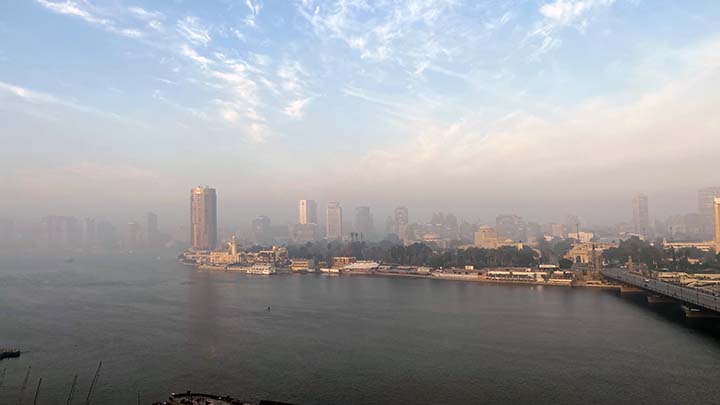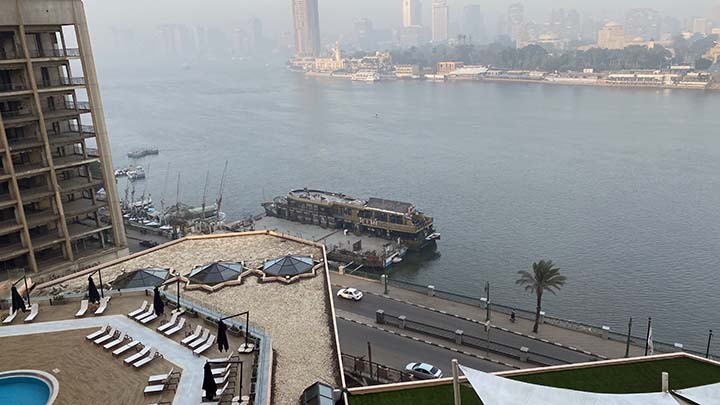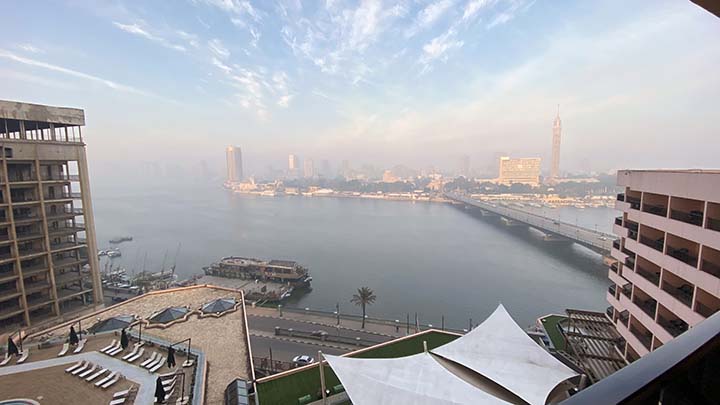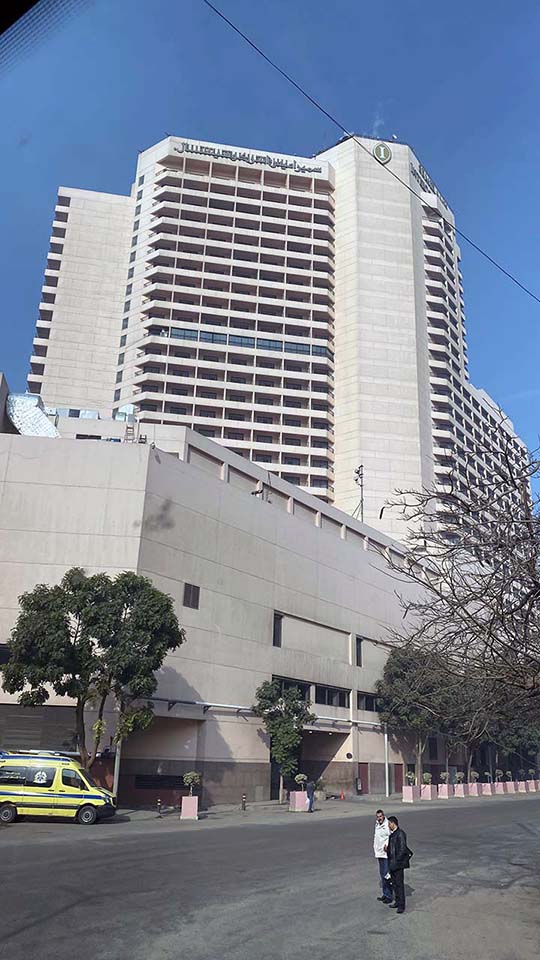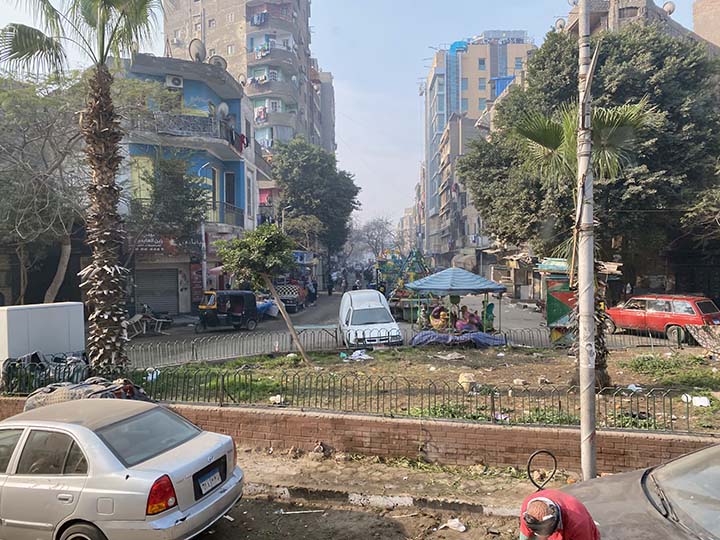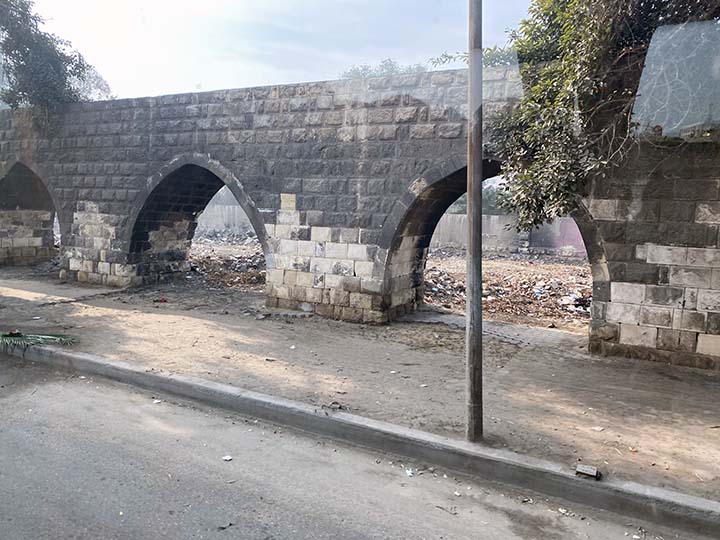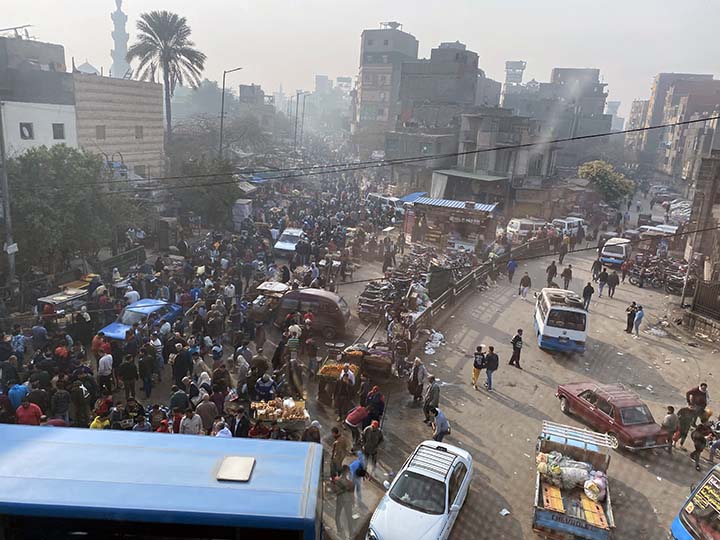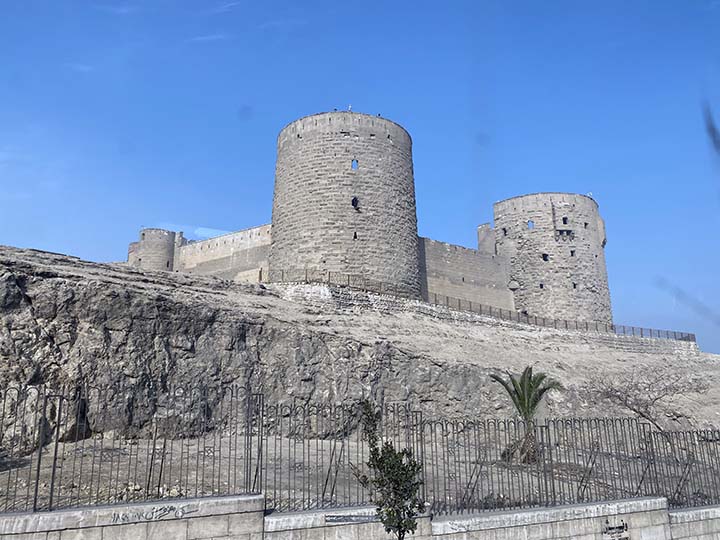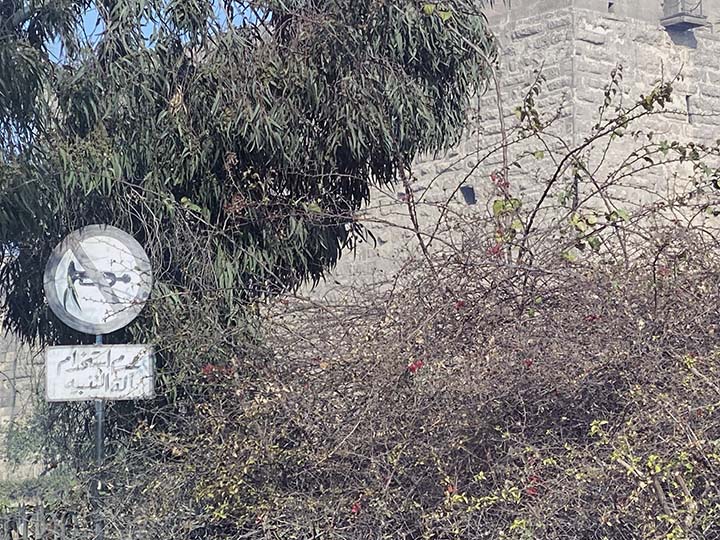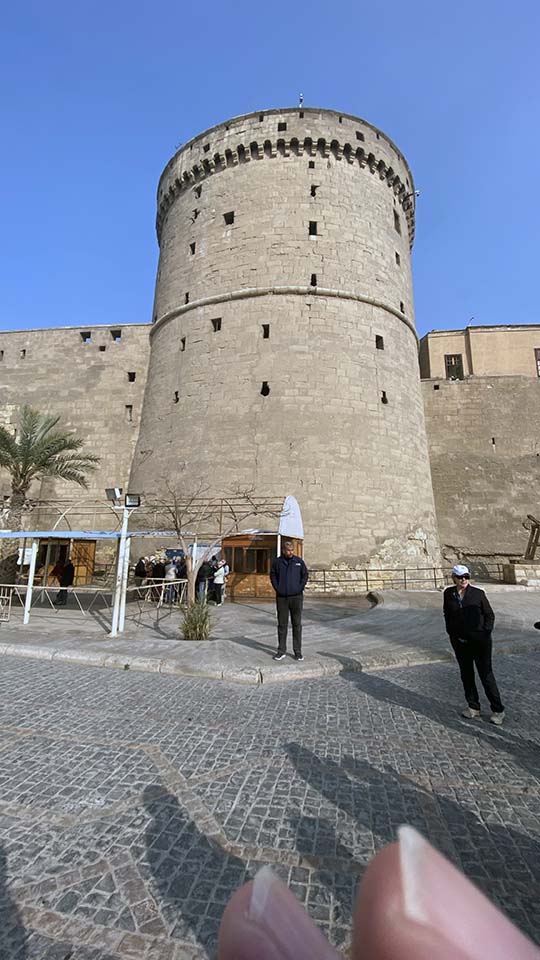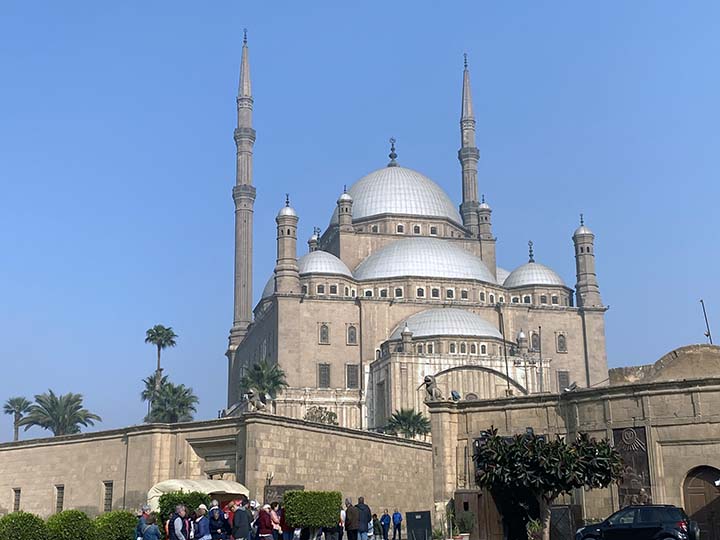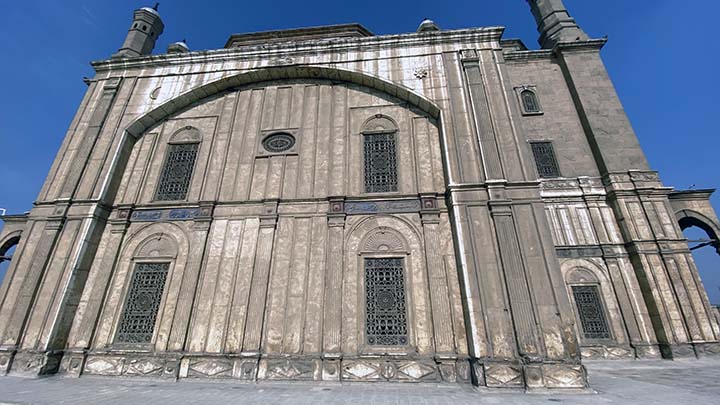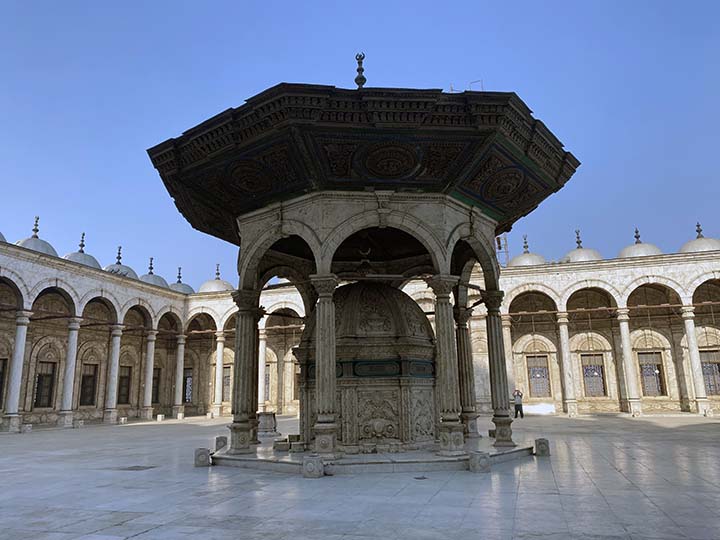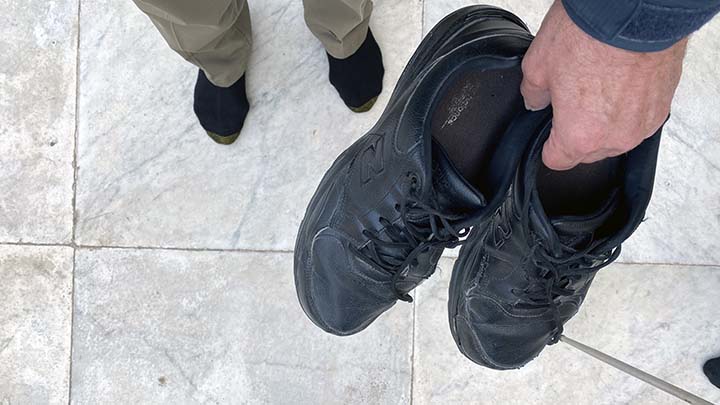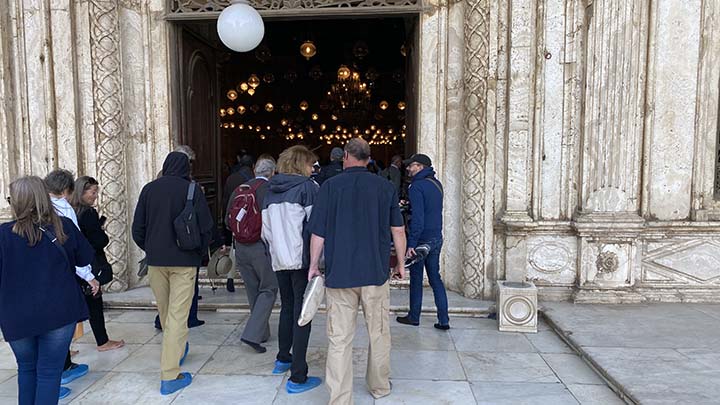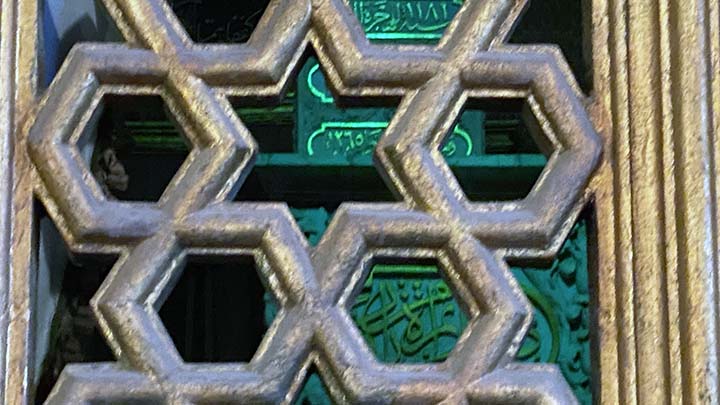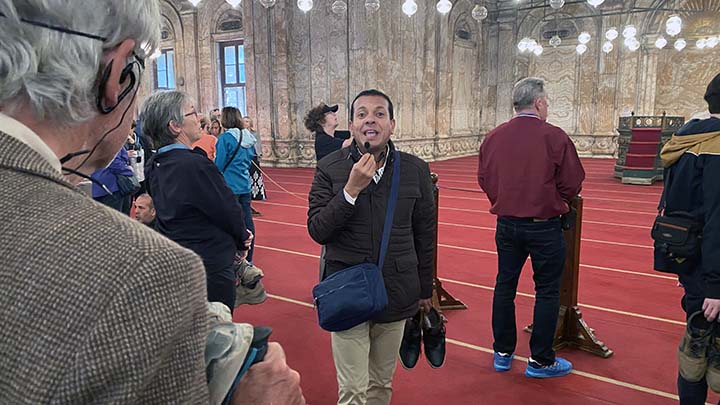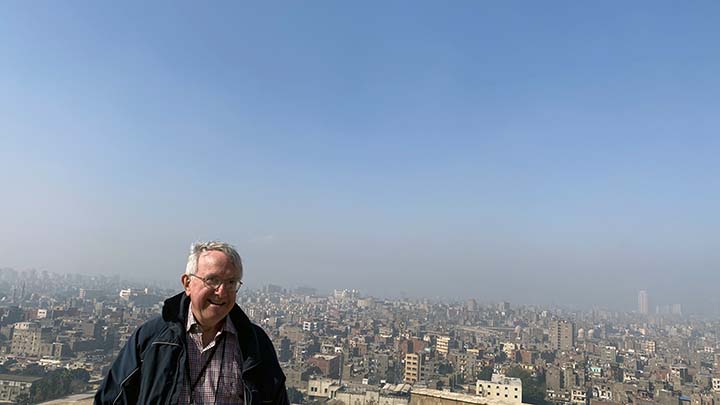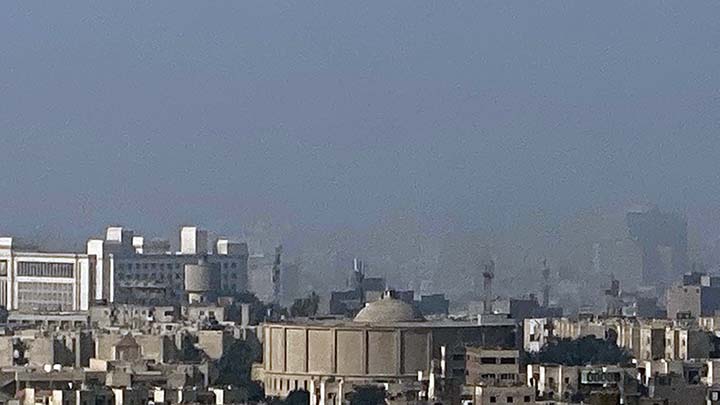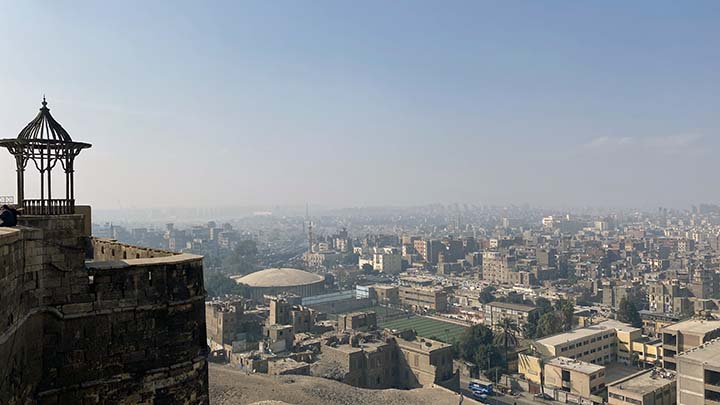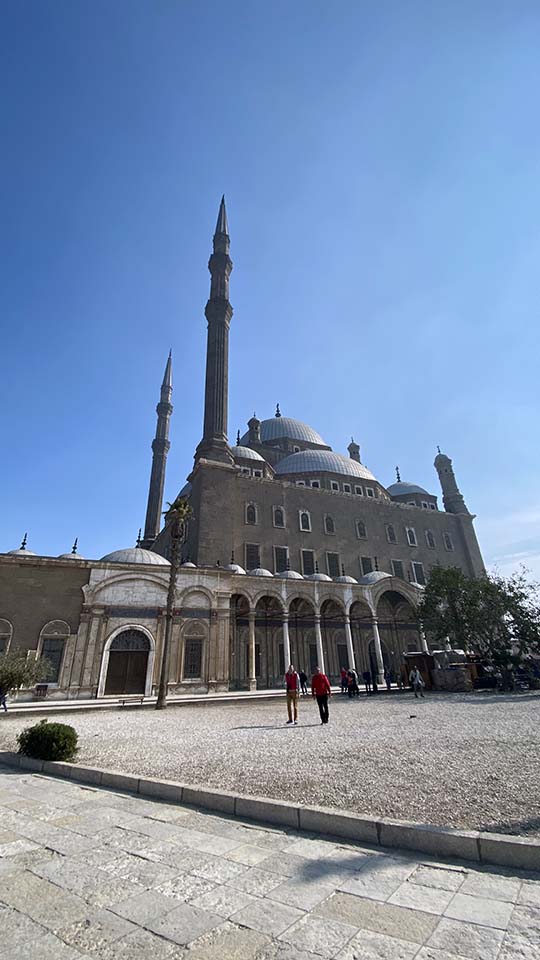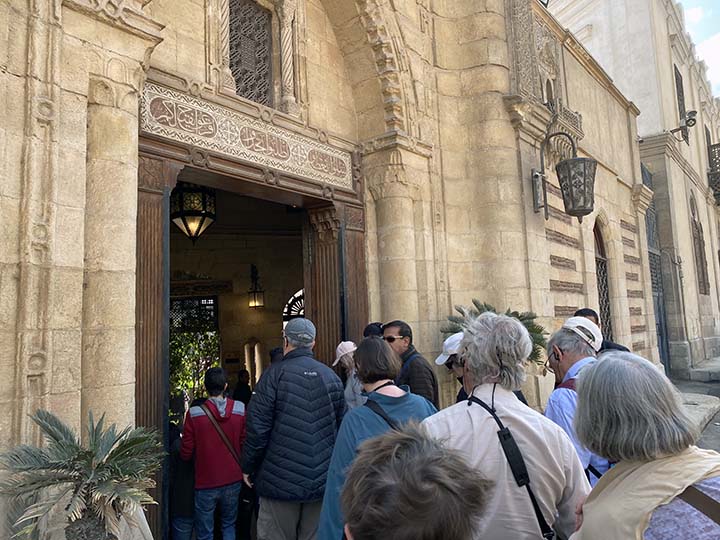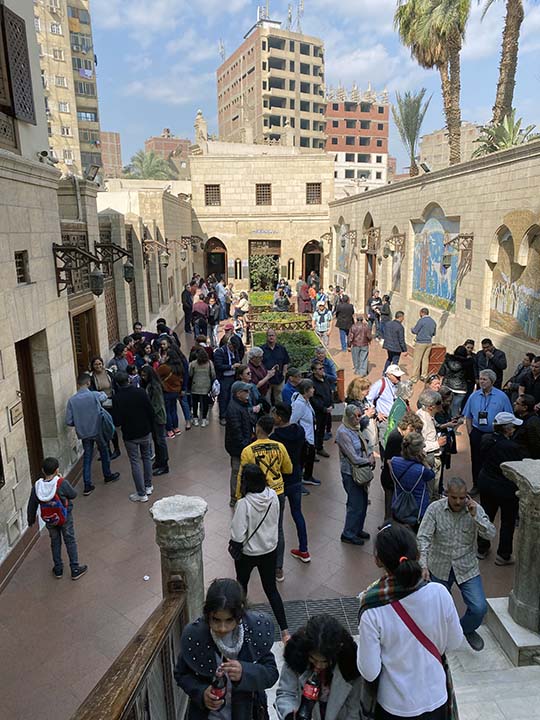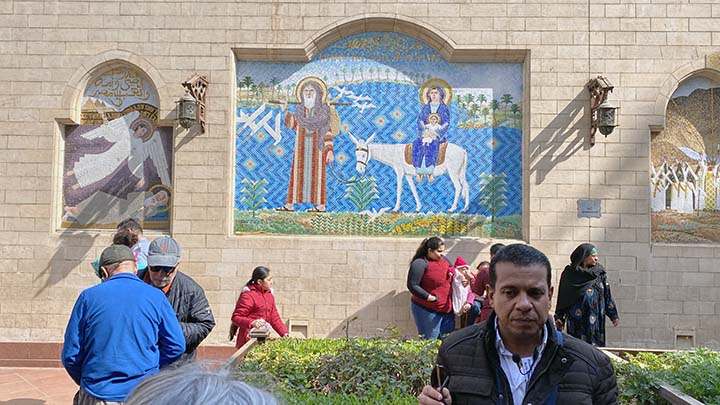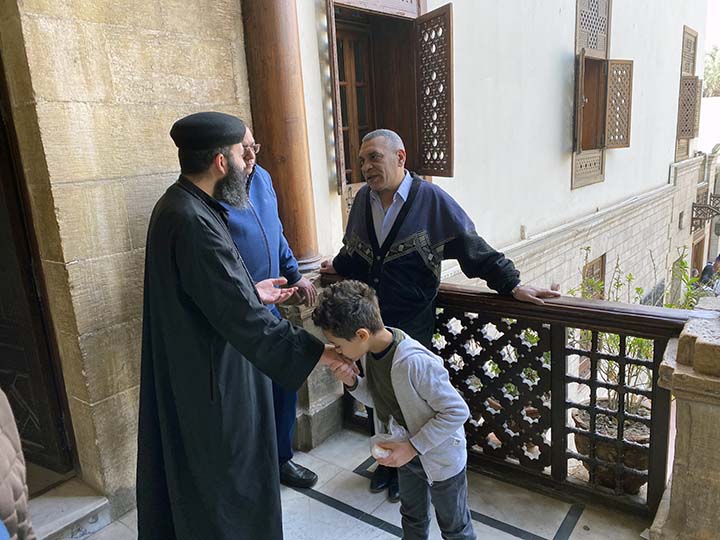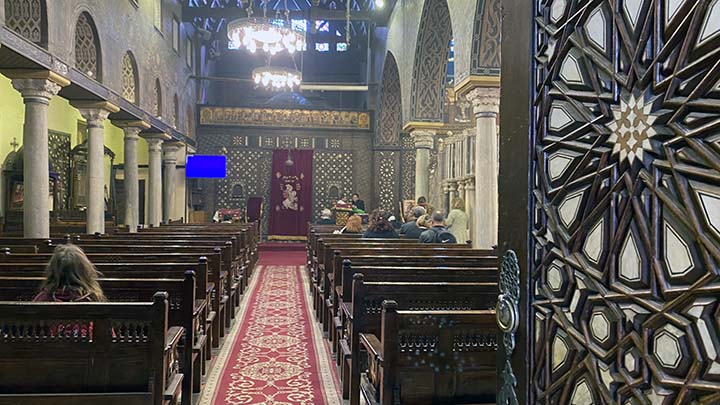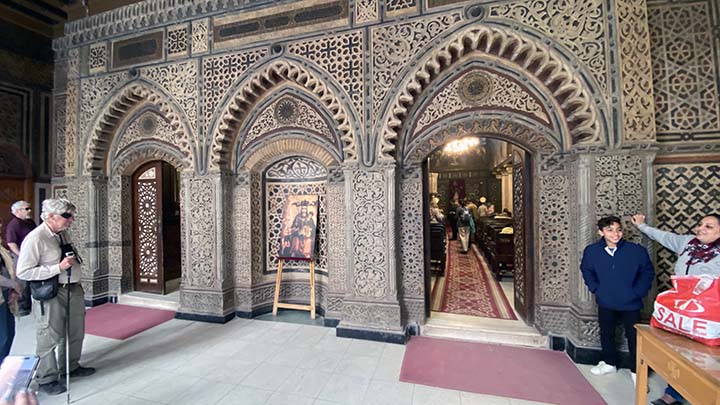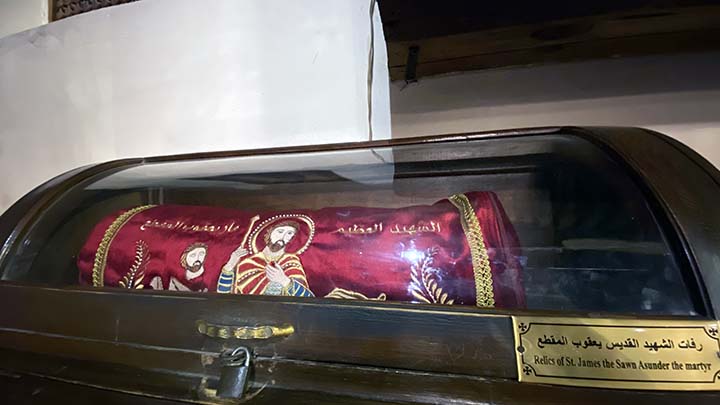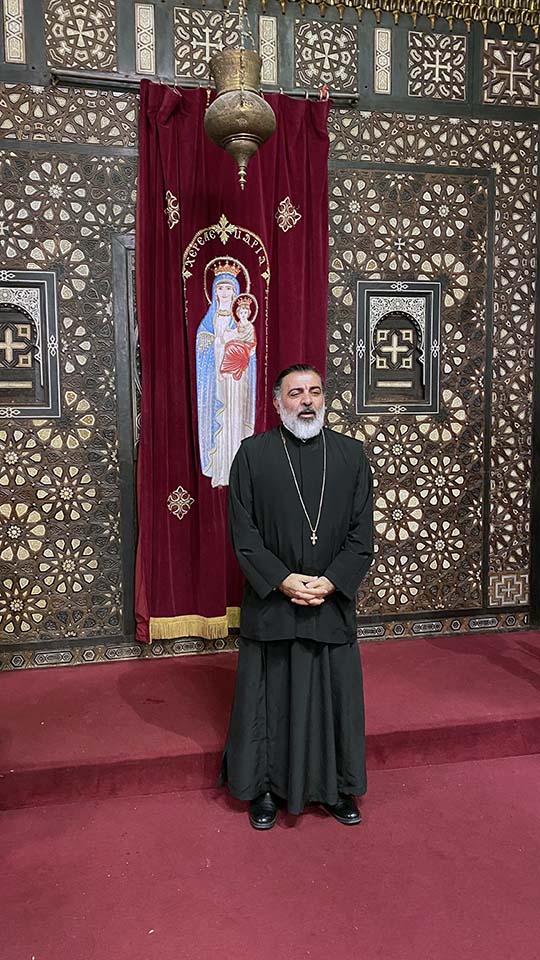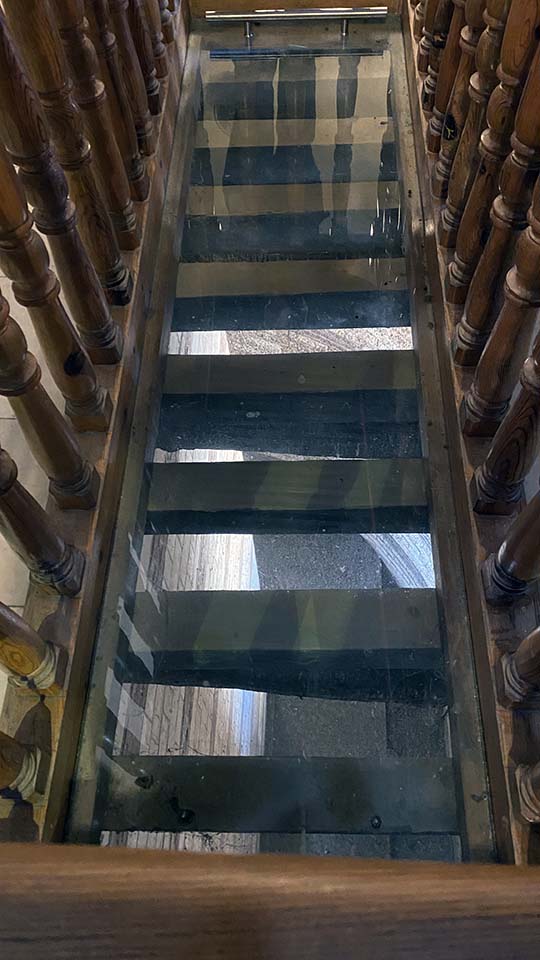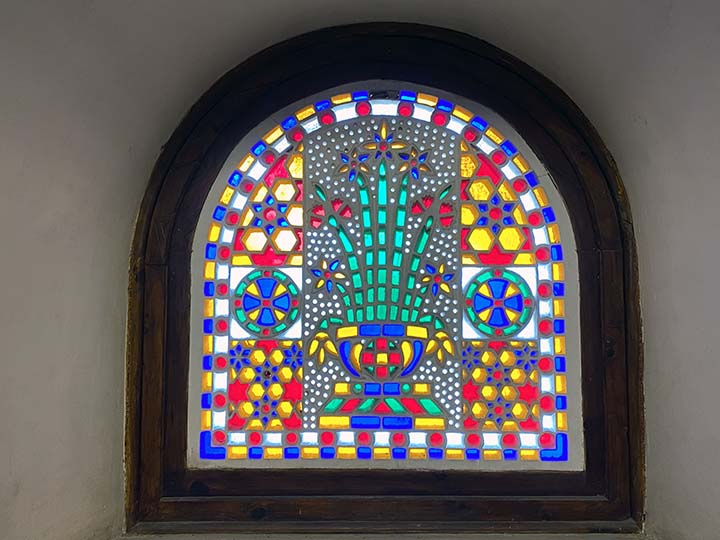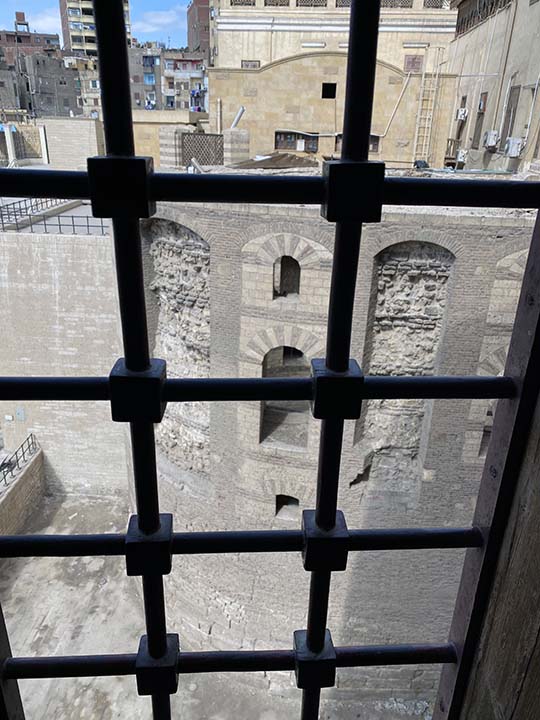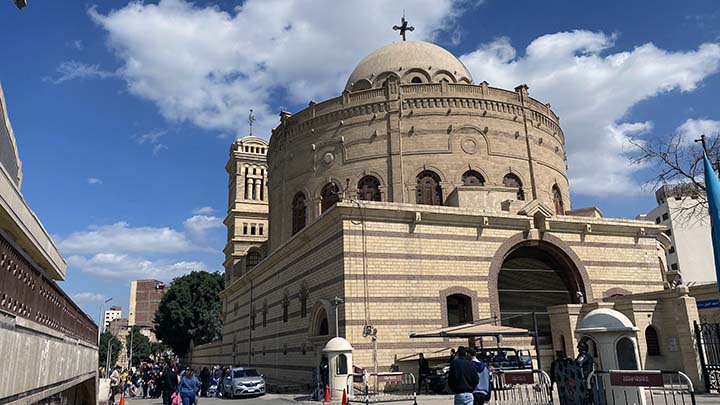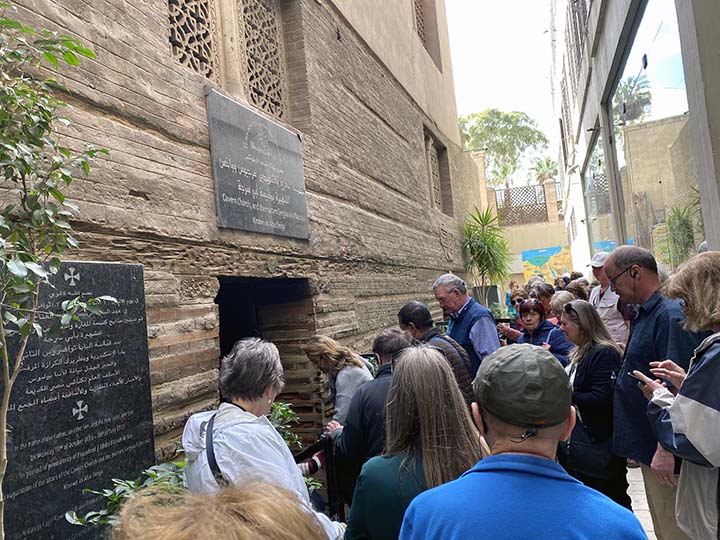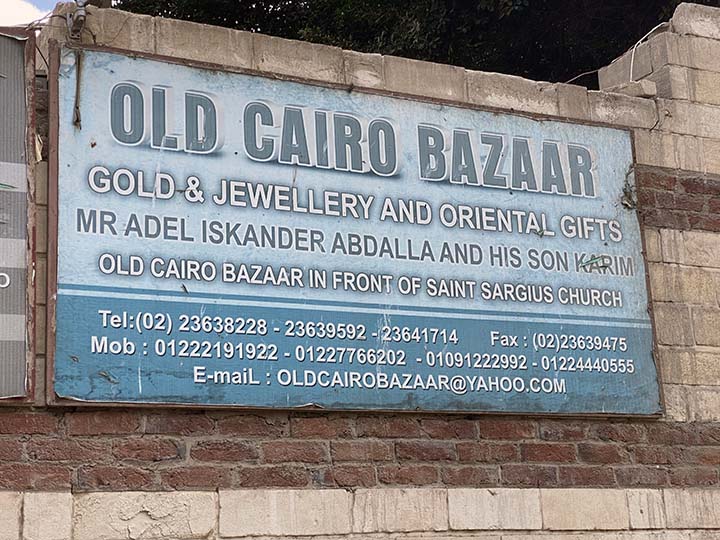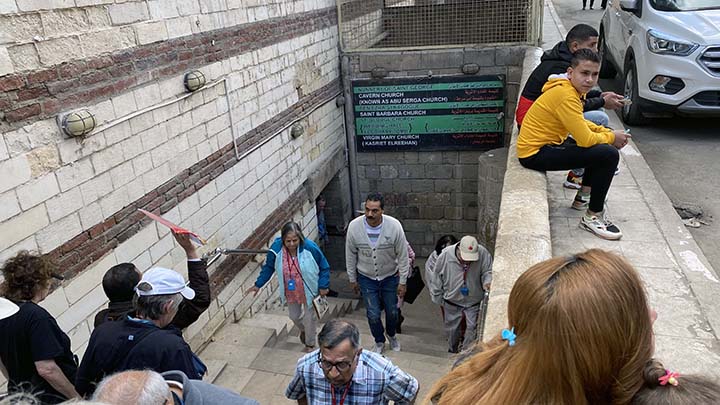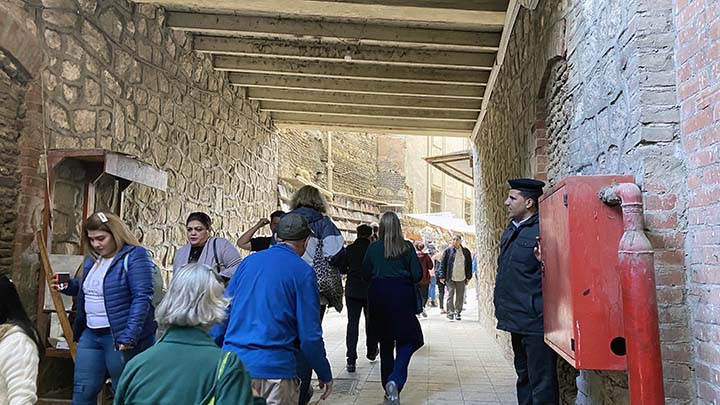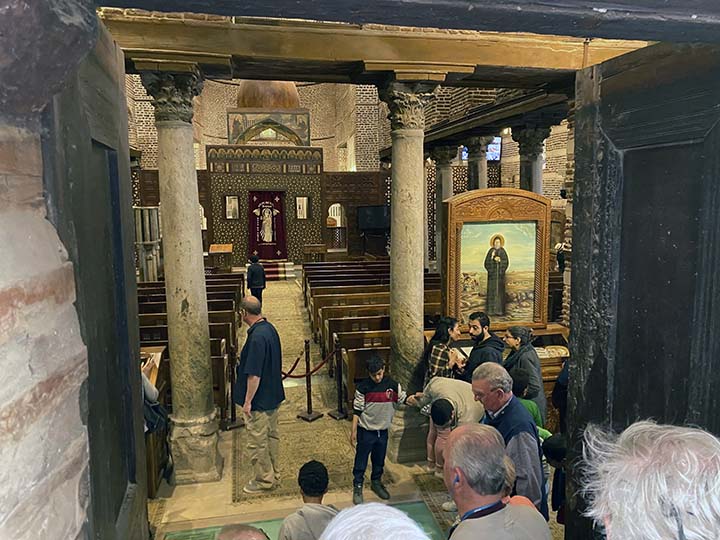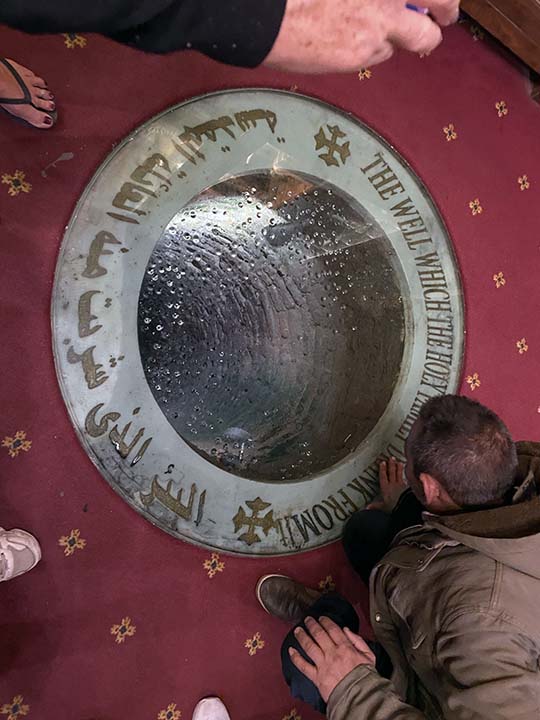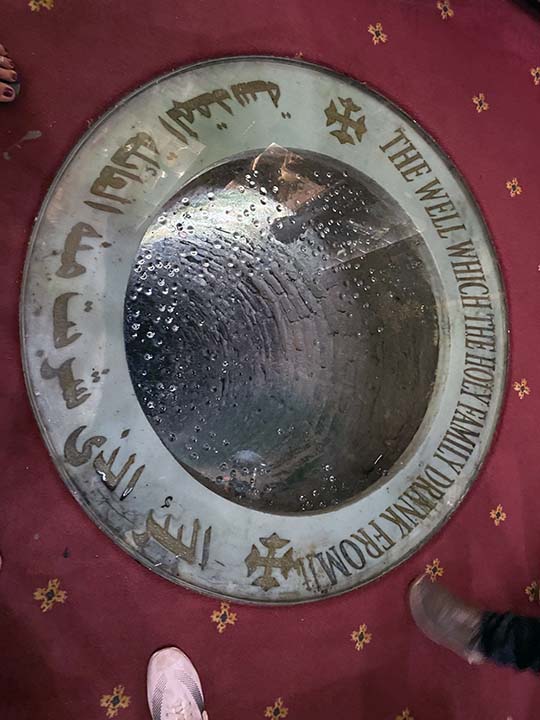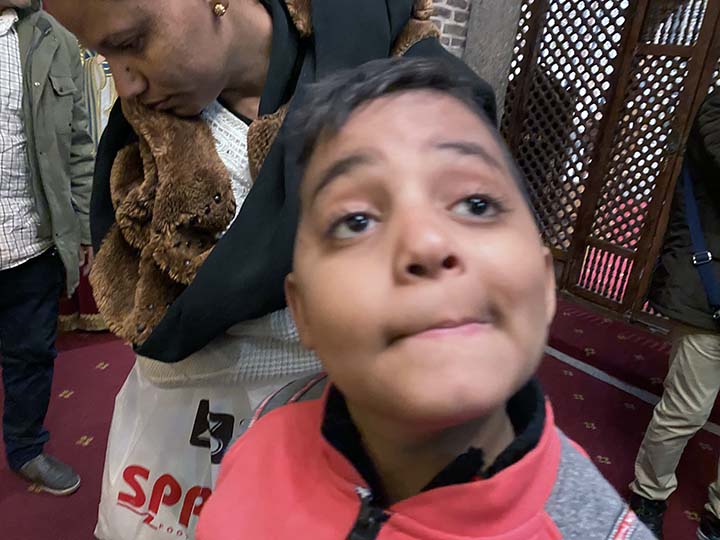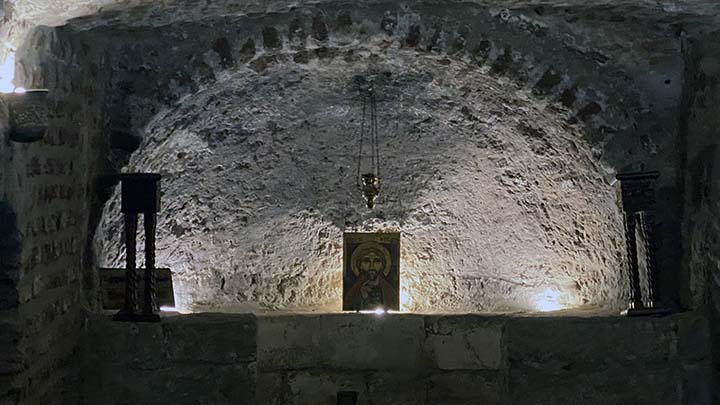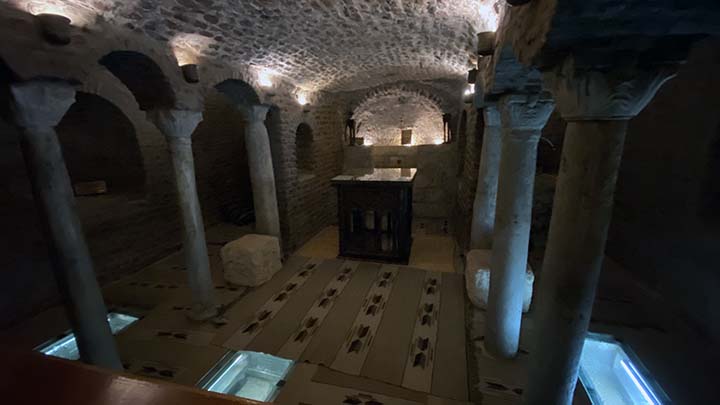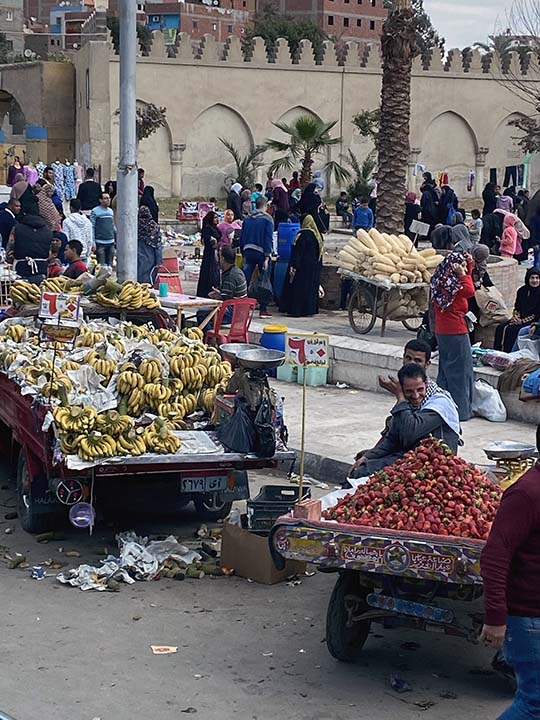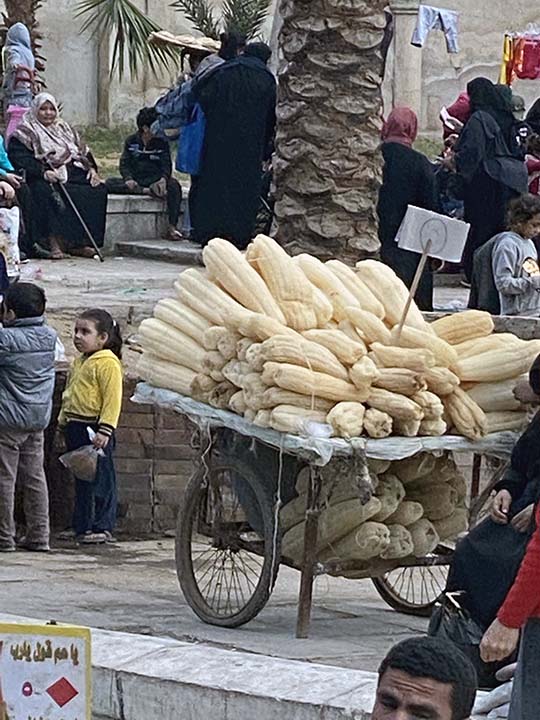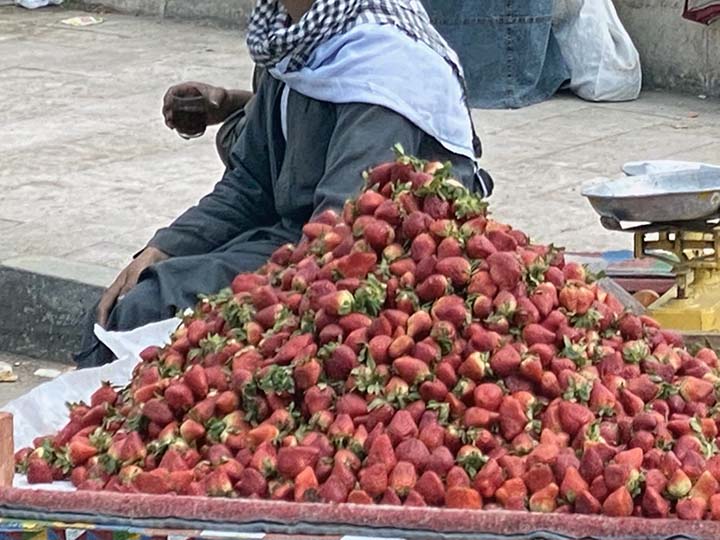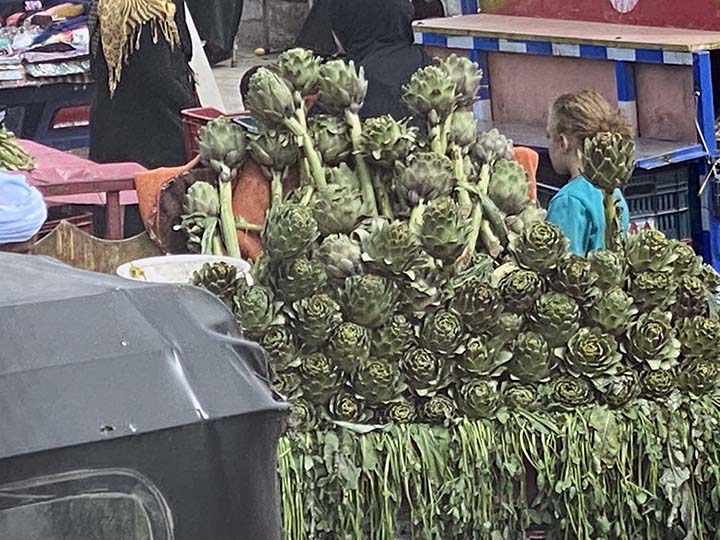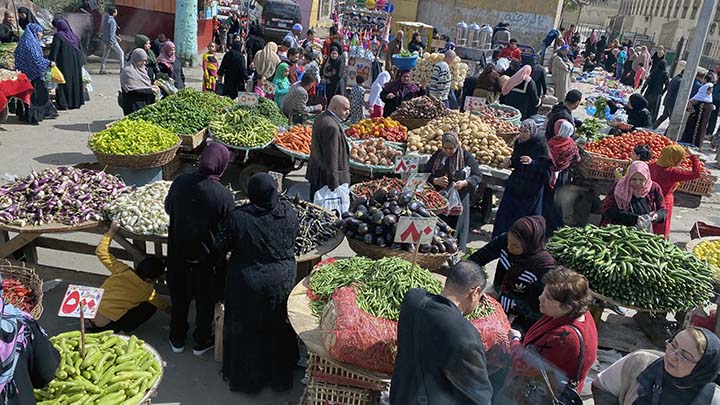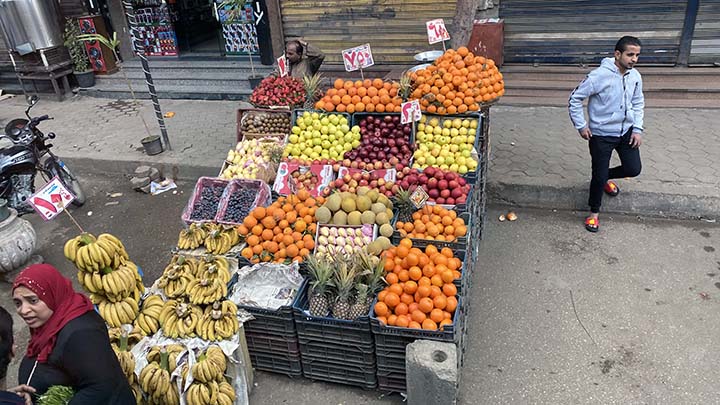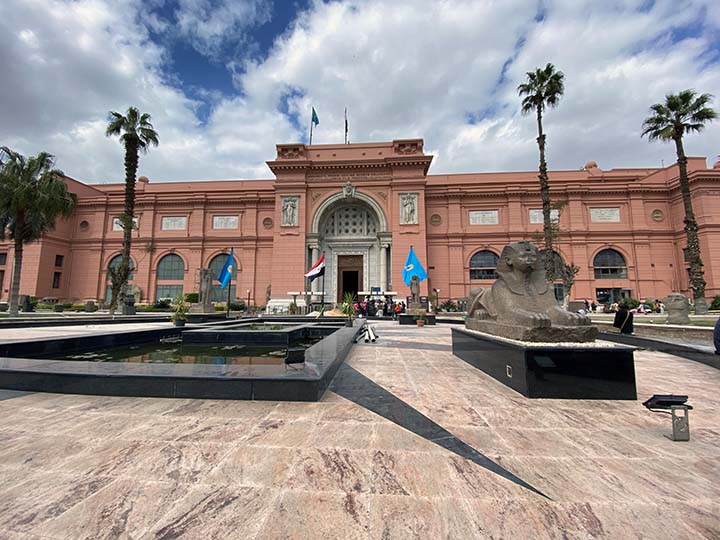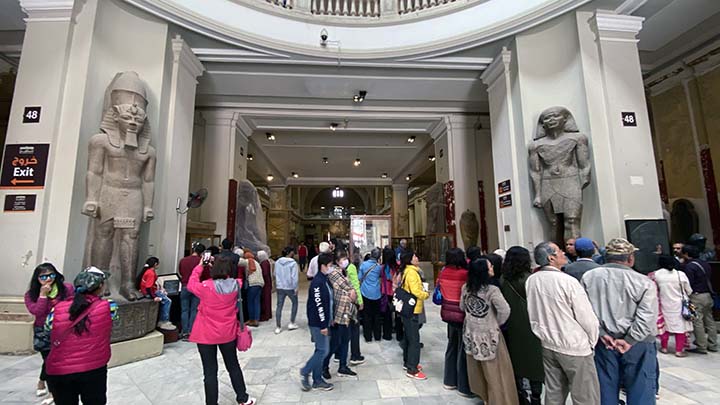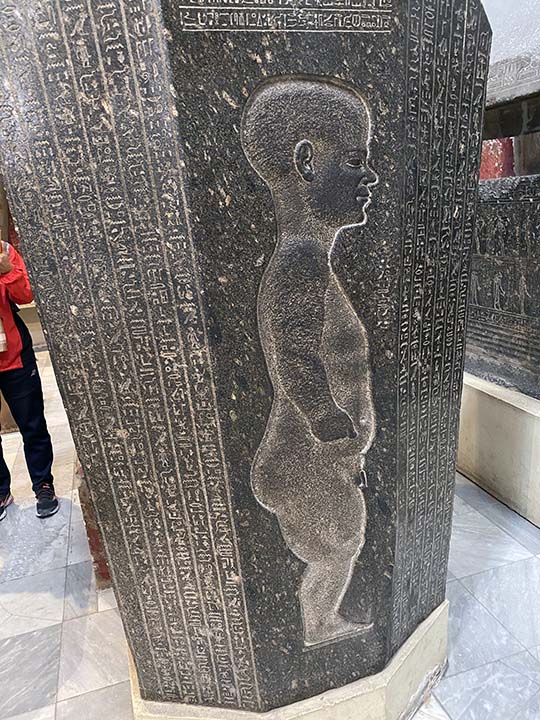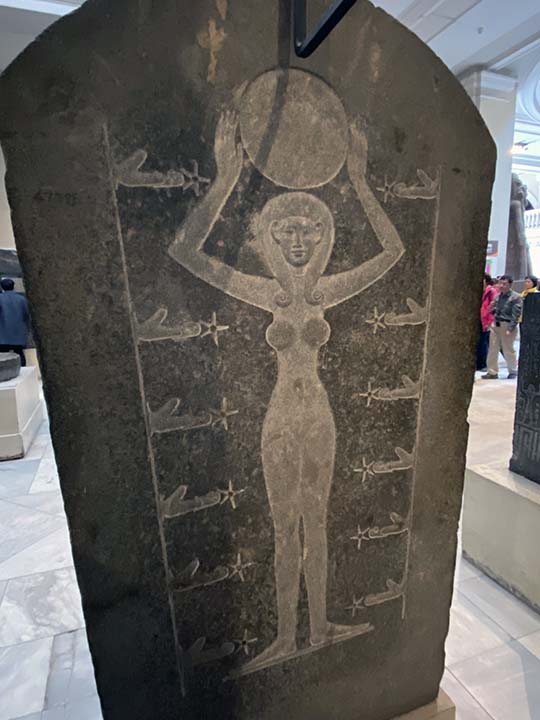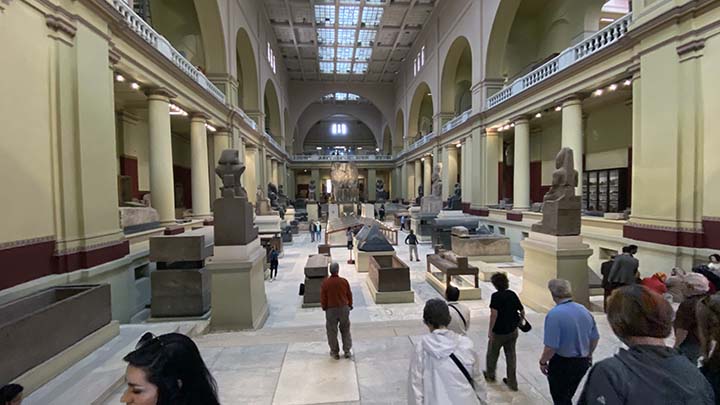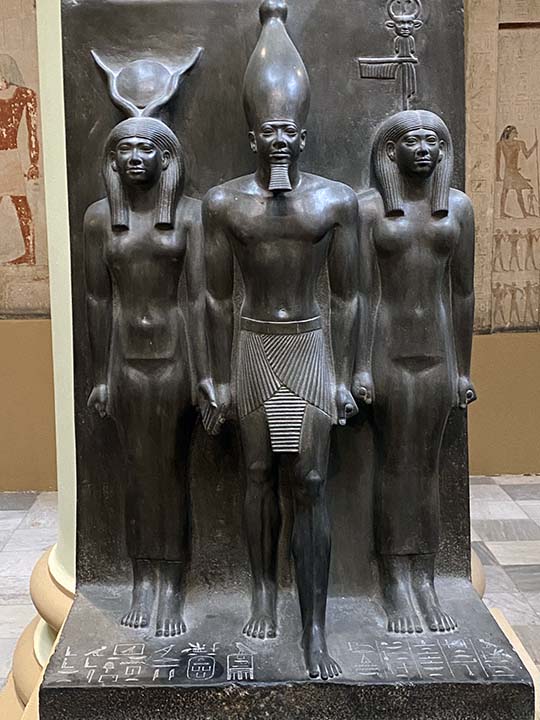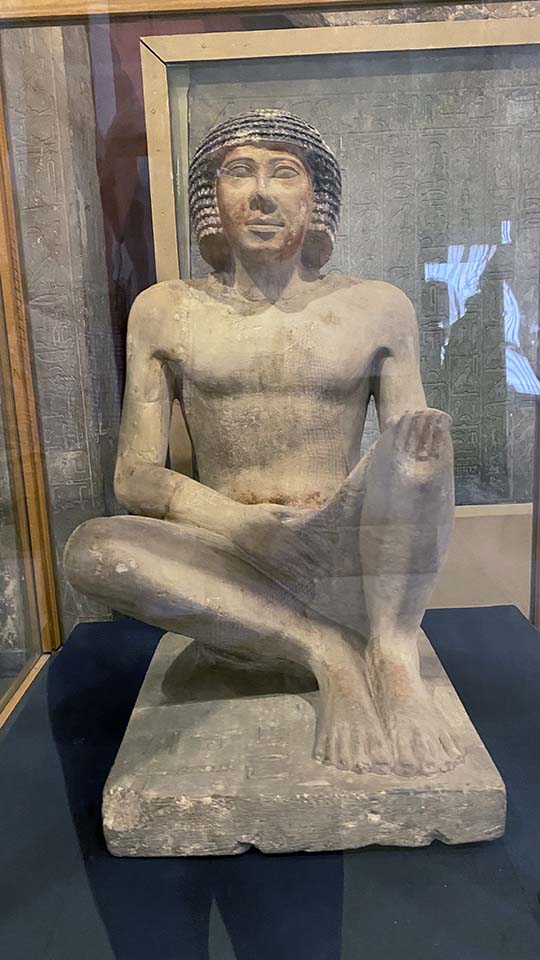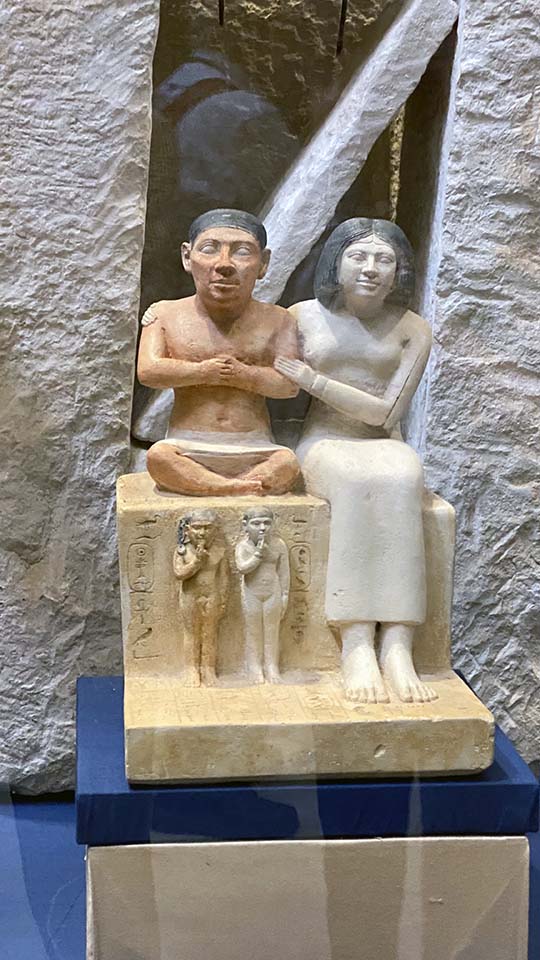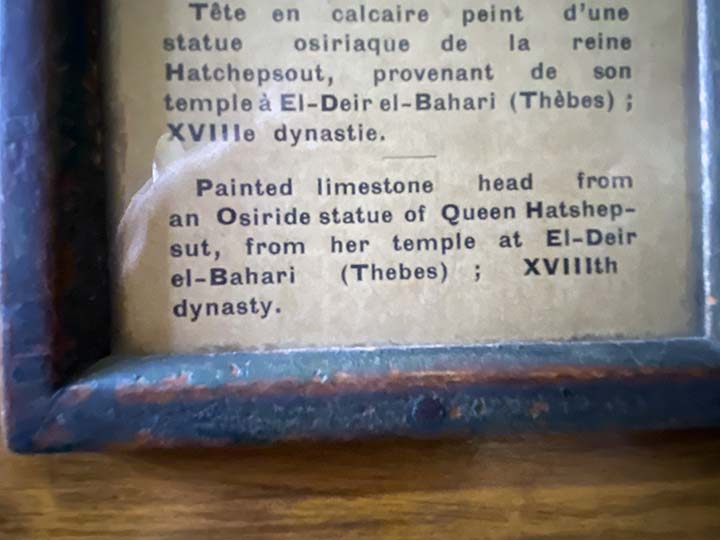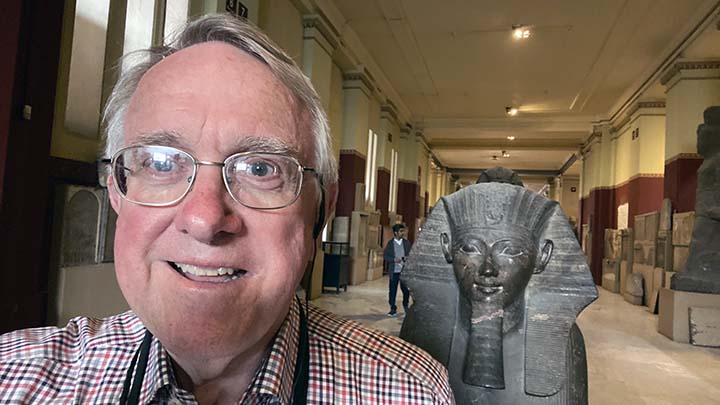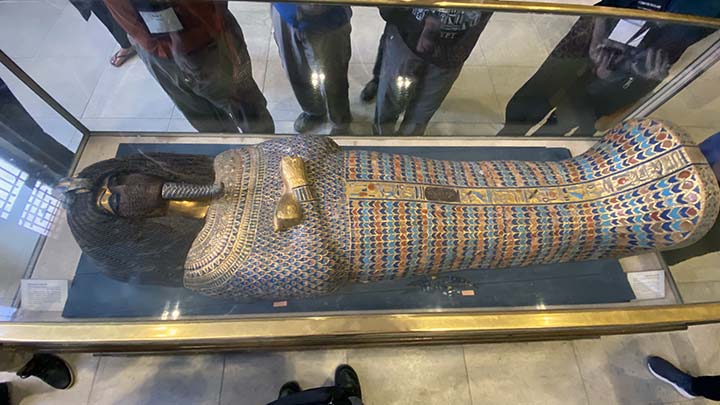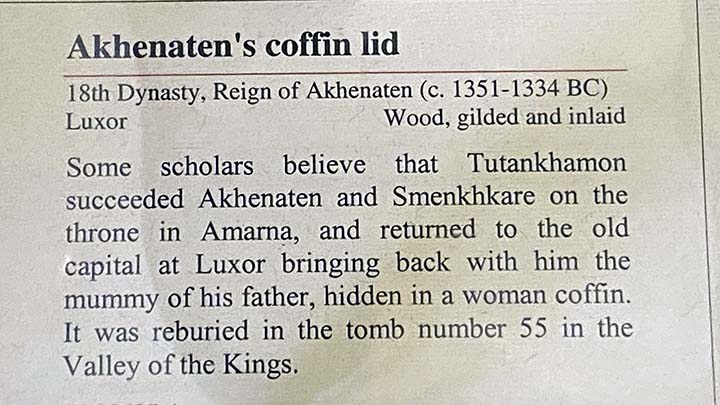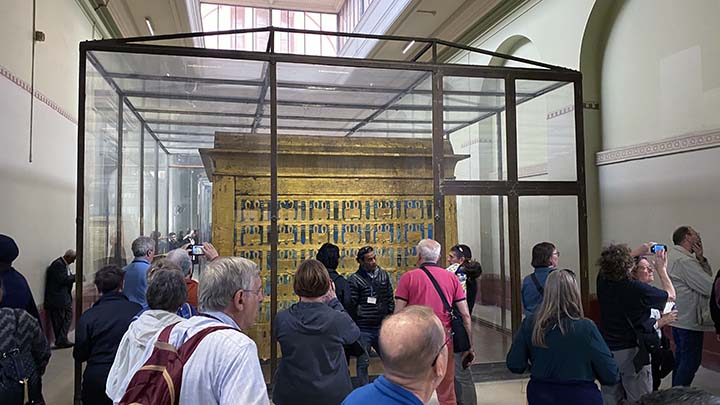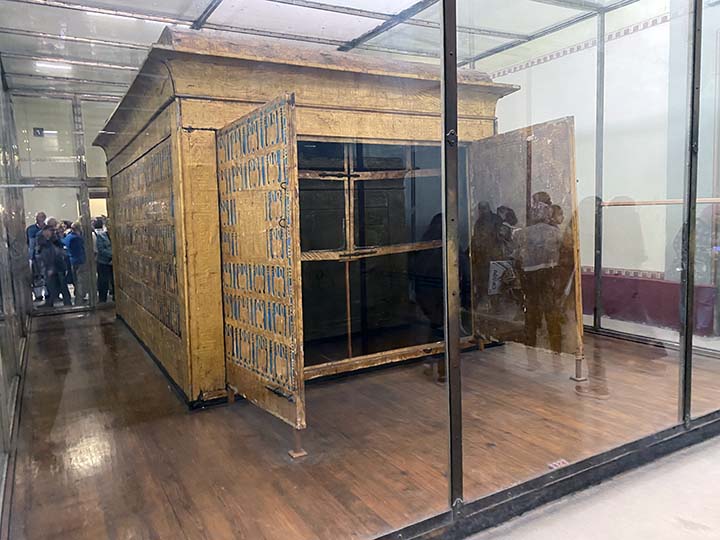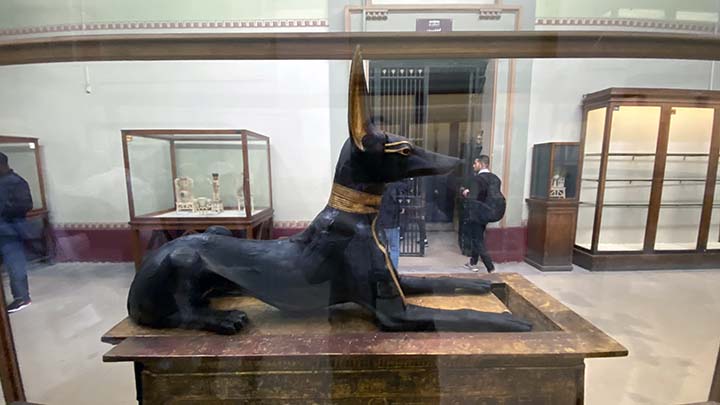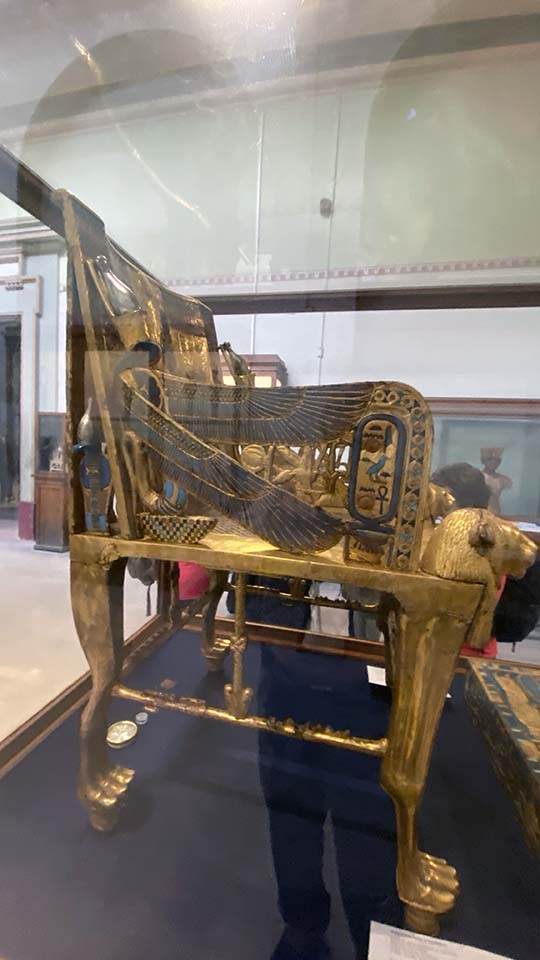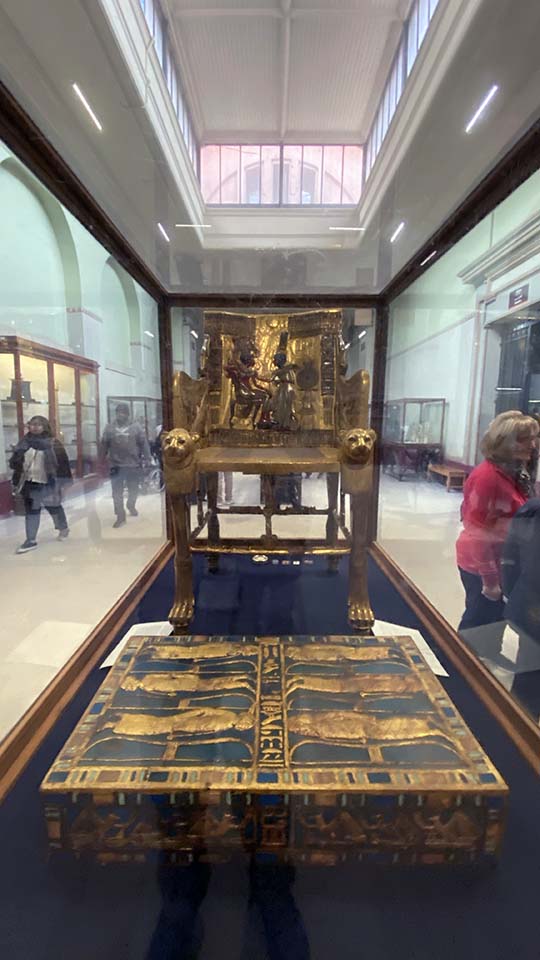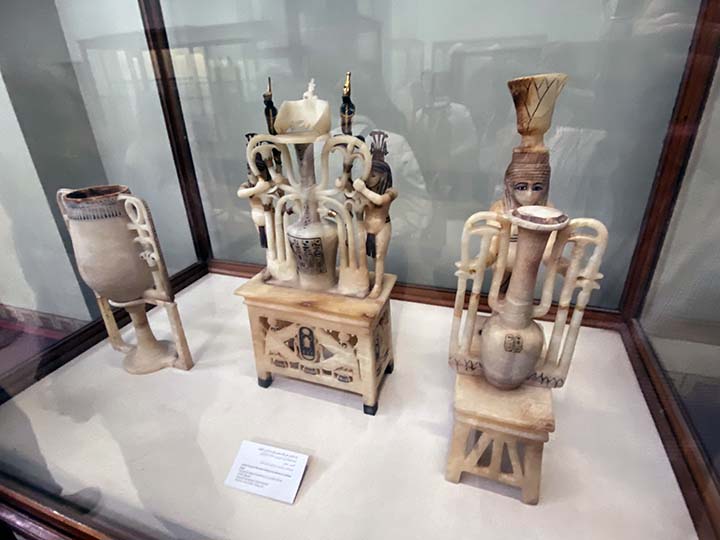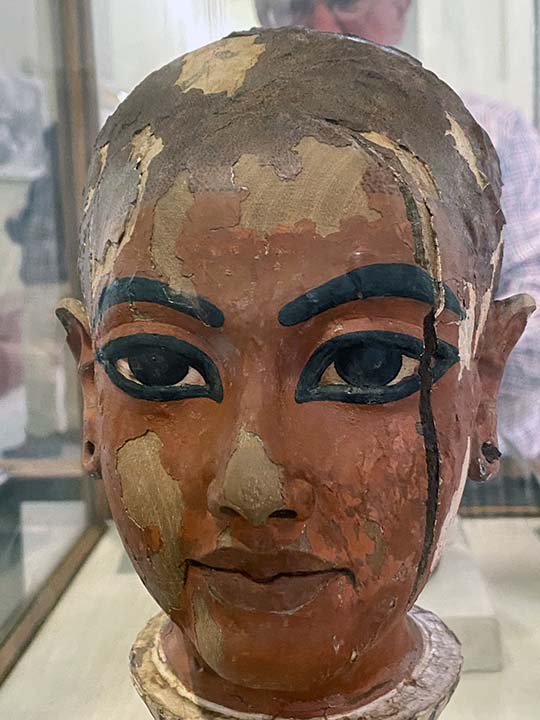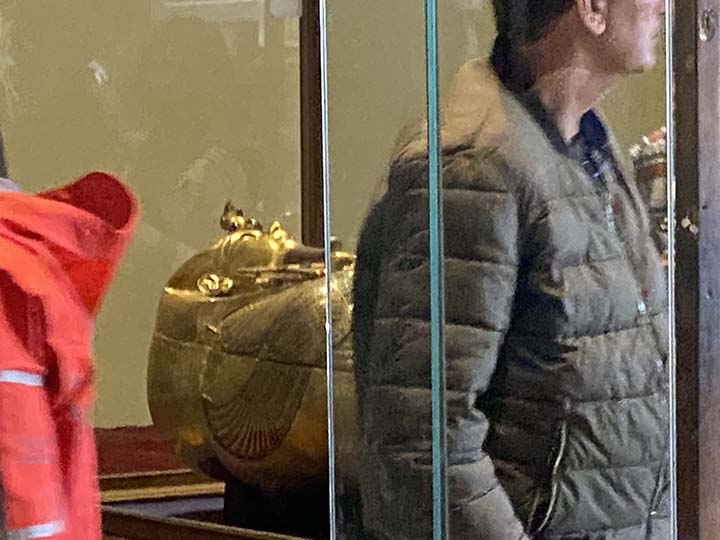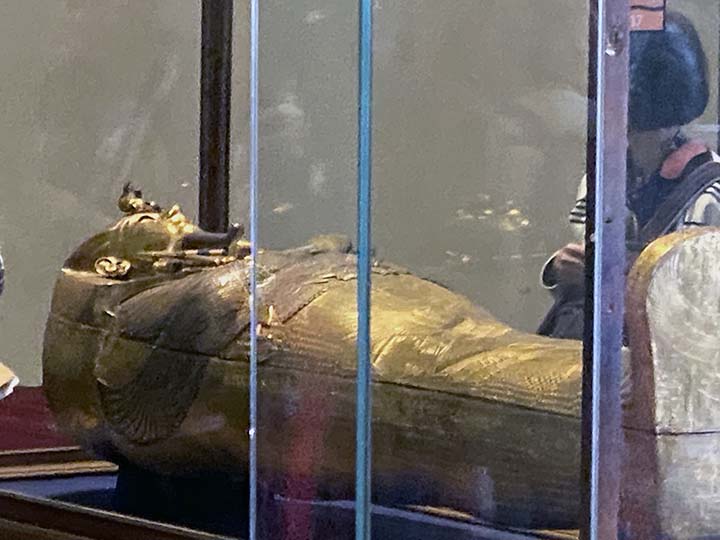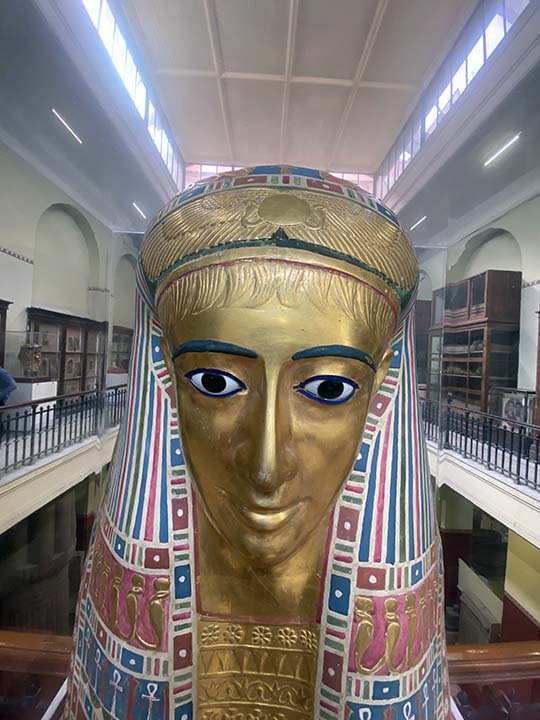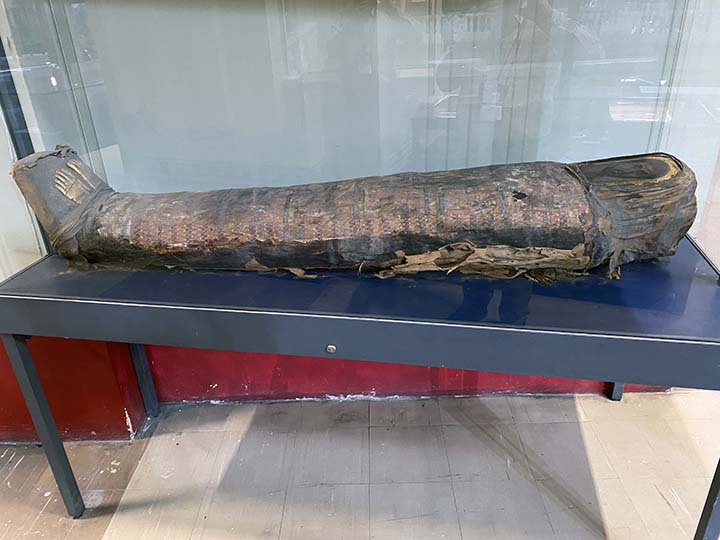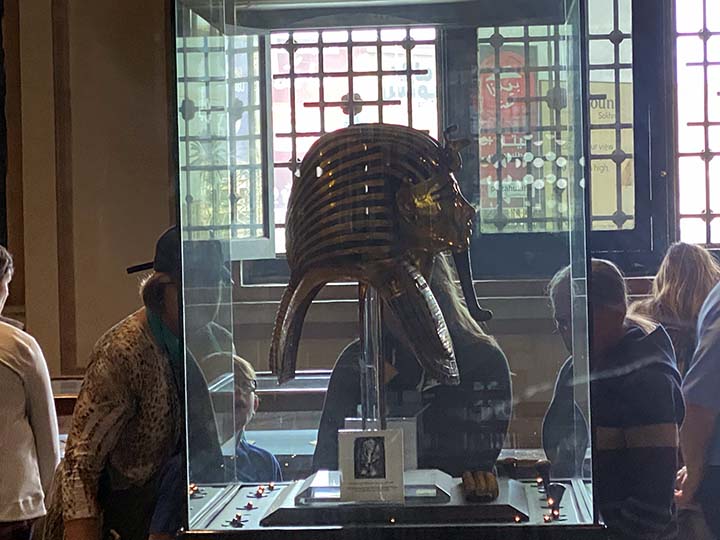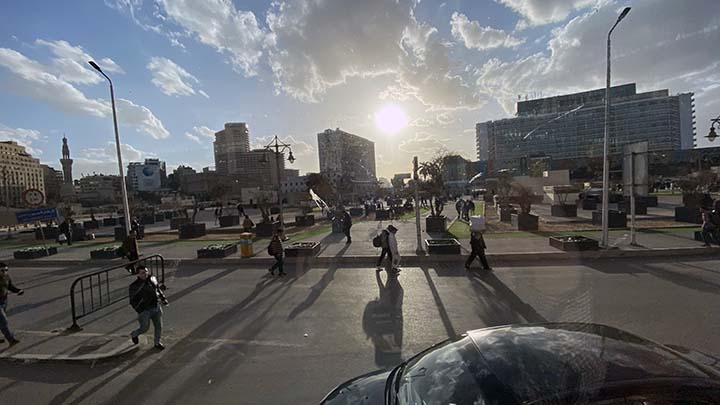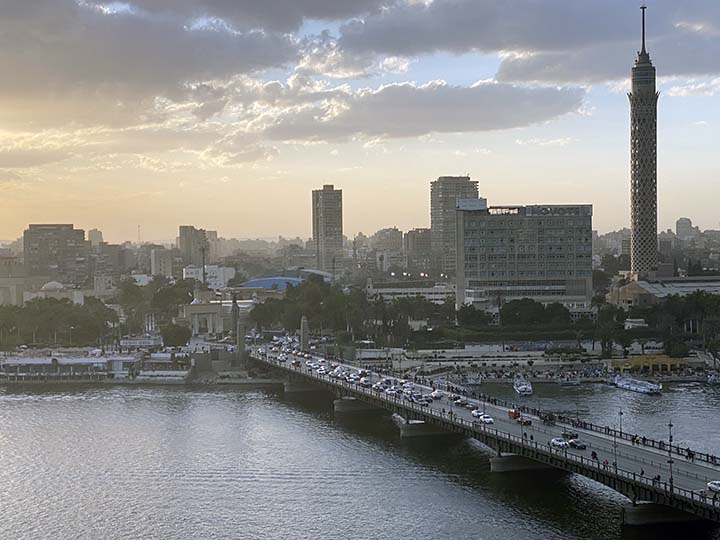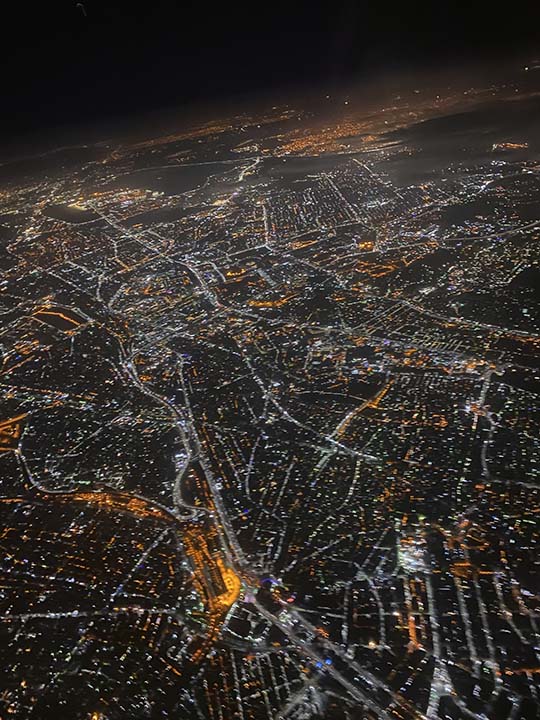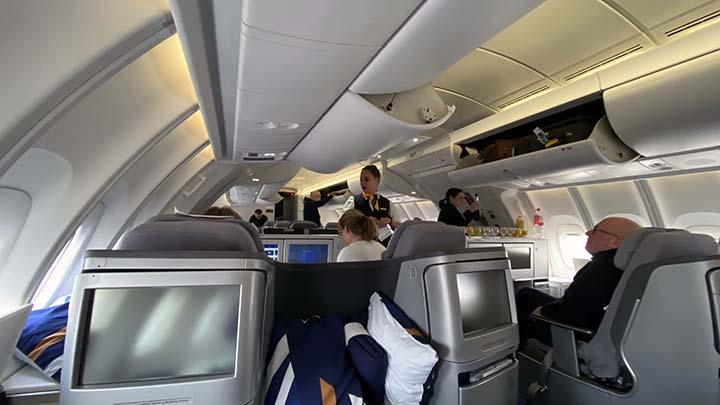|
This is it, the final day, and unless something unusual happens on my flight home tonight, this will be the last entry in this trip log. Itís been great, but Iím ready to go home now. (Actually something did happen on the way home -- I got really sick. I barfed over the Atlantic on the way to New York, and then I barfed over Virginia on my way to Atlanta. It was a miserable, nightmarish flight home and for a while there in New York I considered chucking everything and calling an ambulance. But I persevered and made it all the way home and lived to tell the tale. But let's not think about that now as we're about to embark on our final day of exploration in Egypt. Sure, I'm about to have a horrible night, but I don't know that yet.)
Morning view of Cairo from my balcony. That is pollution; the air is irritating; I would not like to live in Cairo.
Nice hotel. Horrible air quality.
Yuck, just yuck.
That's Tahrir Square, right there by our hotel. You remember Tahrir Square, don't you? If you don't, just click on the link and read about it. Or maybe this will be enough: Tahrir Square was the focal point of the 2011 Egyptian Revolution against former president Hosni Mubarak. Over 50,000 protesters first occupied the square on 25 January, during which the area's wireless services were reported to be impaired. In the following days, Tahrir Square continued to be the primary destination for protests in Cairo. On 29 January, Egyptian fighter aircraft flew low over the people gathered in the square. On 30 January, the seventh day of the protests, PIK BBC and other correspondents reported that the number of demonstrators had grown to at least 100,000, and on 31 January, Al Jazeera correspondents reported that the demonstrations had grown to at least 250,000 people. On 1 February, Al Jazeera reported that more than one million protesters peacefully gathered in the square and adjacent streets. However, such media reports that so many people congregated in Cairo's largest public square are believed to be exaggerated for political purposes and, according to Stratfor's analysis, the real number of gathered protesters never exceeded 300,000 people.
Our hotel.
On our way to the Citadel of Cairo we pass crowded streets.
And dirty streets -- and an aqueduct.
Did I mention crowded, dirty streets?
The Citadel of Cairo or Citadel of Saladin is a medieval Islamic-era fortification in Cairo, Egypt, built by Salah ad-Din (Saladin) and further developed by subsequent Egyptian rulers. It was the seat of government in Egypt and the residence of its rulers for nearly 700 years from the 13th to the 19th centuries. Its location on a promontory of the Mokattam hills near the center of Cairo commands a strategic position overlooking the city and dominating its skyline. At the time of its construction, it was among the most impressive and ambitious military fortification projects in the world. It is now a preserved historic site, including mosques and museums.
No horns.
In addition to the initial Ayyubid-era construction begun by Saladin in 1176, the Citadel underwent major development during the Mamluk Sultanate that followed, culminating with the construction projects of Sultan al-Nasir Muhammad in the 14th century. In the first half of the 19th century Muhammad Ali Pasha demolished many of the older buildings and built new palaces and monuments all across the site, giving it much of its present form. In the 20th century it was used as a military garrison by the British occupation and then by the Egyptian army until being opened to the public in 1983. In 1976, it was proclaimed by UNESCO as a part of the World Heritage Site Historic Cairo (Islamic Cairo) which was "the new center of the Islamic world, reaching its golden age in the 14th century." Apparently there are fingernails at the Citadel too. The tourist needs a manicure.
The Great Mosque of Muhammad Ali Pasha or Alabaster is a mosque situated in the Citadel of Cairo in Egypt. It was commissioned by Muhammad Ali Pasha between 1830 and 1848. Apparently no relation to Cassius Clay.
Situated on the summit of the citadel, this Ottoman mosque, the largest to be built in the first half of the 19th century, is, with its animated silhouette and twin minarets, the most visible mosque in Cairo. The mosque was built in memory of Tusun Pasha, Muhammad Ali's oldest son, who died in 1816.This mosque, along with the citadel, is one of the landmarks and tourist attractions of Cairo and is one of the first features to be seen when approaching the city from any direction.
It is alabaster and it should be white, but you know, Cairo air. It's just plain dirty and it needs a good scrubbing.
In the middle of the courtyard is a marble ablution fountain with a carved wooden roof on columns. The fountain is lavishly decorated in a style similar to that of the sabil-kuttab facing the madrasa of al-Nasir on Mu'izz street. That structure was built by Ismail Pasha in 1828. The sabil and the upper part of the courtyard facade are decorated with small oval wall paintings on which Mediterranean landscapes are represented.
The tourist took off his shoes, of course, before going into the mosque. He is now confident that they will survive the entire trip without falling completely apart, and he will turn out to be right. When he got home, though, they went straight to the garbage can and Amazon kindly sent him another pair just like them.
Now free of shoes, the Road Scholars pad softly inside.
Originally, the planning of this mosque was assigned to Muhammad Ali's French architect, Pascal Coste, who probably would have built it in the local Mamluk style judging from his interest in Cairo's traditional architecture. However, for some unknown reason, Muhammad Ali changed his mind and hired a Greek architect, Yusuf Bushnaq, to design the mosque on a plan similar to that of the Mosque of Sultan Ahmad in Istanbul (known as the Blue Mosque).
Muhammad Ali himself is in a tomb behind that door. I donít know why they have it lit in dim green.
Rafik explains it all.
While the tourist stands outside on the parapet and enjoys the air pollution.
I guess I've seen Los Angeles look like this in years past. But still...yuck.
If only this pretty view were a pretty view.
By to the mosque.
Let's go see a church.
Saint Virgin Mary's Coptic Orthodox Church (Coptic: Church of Mother of God Saint Mary in Egyptian Babylon), also known as the Hanging Church, is one of the oldest churches in Egypt and the history of a church on this site dates to the third century. It belongs to the Coptic Orthodox Church of Alexandria. The Coptic Christian Church is basically the Egyptian version of Greek Orthodox. They say the liturgy of the Coptic Christian church echoes the language spoken by the ancient Egyptians. Thereís lots of bustle here today as they are apparently already getting ready for Easter.
Rafik explains it all. He is Coptic Christian, by the way.
The priest is revered.
They call this the Hanging Church. It is one of the oldest churches in Egypt and the history of a church on this site dates to the third century. The Hanging Church is named for its location above a gatehouse of Babylon Fortress, the Roman fortress in Coptic Cairo (Old Cairo); its nave is suspended over a passage.
They have relics of lots of Saints on display. I think that's some poor guy's arm.
That's the preacher. Everybody seemed to like him.
Through glass we can see evidence of an earlier church on this spot.
The church has a very nice stained glass window.
They say Romans used to walk out there.
The Church of St. George is a Greek Orthodox church within the Babylon Fortress in Coptic Cairo. It is part of the Holy Patriarchal Monastery of St George under the Greek Orthodox Patriarchate of Alexandria and all Africa. The church dates back to the 10th century (or earlier). The current structure was rebuilt following a 1904 fire, construction was finished in 1909. Since 2009, the monastery's hegumen has had the rank of bishop with title Bishop Babylonos ("Bishop of Babylon").
Let's do more shopping in Old Cairo.
Actually we're touring churches now, but we kinda have to retrace some steps from yesterday to do so.
Remember Road Scholars -- churches, not trinkets.
We visited Saints Sergius and Bacchus Church, one of the oldest Coptic churches in Egypt, dating back to the 4th century.
Again, very nice, very impressive, very old. The interesting thing here is Saints Sergius and Bacchus Church is traditionally believed to have been built on the spot where the Holy Family, Joseph, Mary and the infant Jesus Christ, rested at the end of their journey into Egypt. They may have lived here while Joseph worked at the fortress.
Rafik is explaining the place but I can't hear a word he's saying, so let's just have a look around.
Uh oh, people are kissing things again.
It's a window to the well where the Holy Family drank when they lived here.
The kid was fascinated by my cell phone for some reason, so I took his picture and he seemed happy.
This is where Joseph, Mary and Jesus stayed while they were in Egypt.
Yep, no doubt about it. We also visited a synagogue, but they didnít allow pictures, so I donít have any pictures. Too bad, because it was built on the spot where Moses was found in the bulrushes. Yes, that very spot. Isn't it amazing how everybody's so sure about this stuff?
Even more amazing was the open air market that we drove past after we left all the places of worship. It was right there on the street, and it seemed to go on forever. Do you want strawberries? Bananas?
How about a loofah? You can't eat it, though.
But you can eat these, boy. Just look at 'em. The tourist was drooling.
You need artichokes?
This guy will sell you some artichokes.
If you don't make him mad.
But there is plenty more delicious looking produce on offer.
And more and more and more.
Cairo may look distressed, but out there on the streets you'll find good stuff to eat. It's kind of beautiful.
After lunch, in a hotel, not on the street darn it, we went to the Egyptian Museum.
The Museum of Egyptian Antiquities, known commonly as the Egyptian Museum or Museum of Cairo, in Cairo, Egypt, is home to an extensive collection of ancient Egyptian antiquities. It has 120,000 items, with a representative amount on display, the remainder in storerooms.
Built in 1901 by the Italian construction company Garozzo-Zaffarani to a design by the French architect Marcel Dourgnon, the edifice is one of the largest museums in the region. As of March 2019, the museum is open to the public. In 2020 the museum is due to be superseded by the new Grand Egyptian Museum at Giza.
Menkaure flanked by gods. Menkaure (center), pharaoh of the 4th dynasty, flanked by the gods Hathor (left) and Bata (right), stone sculpture, 4th dynasty (c. 2575Ėc. 2465 BCE); in the Egyptian Museum, Cairo. .
A striking aspect of later Egyptian sculpture was the effort to render figures in natural poses.
Like this nice family. They look natural, don't they?
Looks feminine, but there's a beard. Could it be a female pharaoh?
Yep.
The tourist is getting the hang of this.
If you want to remember what you've seen when you get home, just take a picture of the object...
And then take a picture of the description. Whoa...we're getting into the King Tut stuff.
The really have begun moving exhibits from this old museum to the new Egyptian Museum. Fortunately they havenít started moving King Tutís artifacts yet, so a wealth of material from his tomb is on display. This is just one of the Russian doll-type cases that contained his coffin.
It's pretty.
Another of the Russian doll cases for his coffin.
And more.
That's a jackal to keep King Tut company.
And that's his throne.
It's a mighty fine throne.
A closer view.
Yet still closer. Just look at the beautiful decorations. Probably wasn't very comfortable, though.
Even King Tut liked trinkets.
And that is King Tut himself -- a bust of his head anyway. Remember, we saw the real head in his tomb in the Valley of the Kings? He looks much nicer here.
We were absolutely forbidden to take pictures of his gold coffins, but I got sneaky while I was standing outside in the hall.
There's one of his golden coffins. He had several.
Is that supposed to be Tut? Anybody know?
That's a mummy. It's hard to see, but look at the face -- there's a painting there of the fellow who's all wrapped up. This is from the Roman period.
Some of this treasure has traveled worldwide with unprecedented response. The Egyptian Supreme Council of Antiquities allowed tours beginning in 1962 with the exhibit at the Louvre in Paris, followed by the Kyoto Municipal Museum of Art in Tokyo, Japan. The exhibits drew in millions of visitors. The 1972Ė1979 exhibit was shown in United States, Soviet Union, Japan, France, Canada, and West Germany. There were no international exhibitions again until 2005Ė2011. This exhibit featured Tutankhamun's predecessors from the 18th Dynasty, including Hatshepsut and Akhenaten, but did not include the golden death mask. The treasures 2019Ė2022 tour began in Los Angeles and will end in 2022 at the new Grand Egyptian Museum in Cairo, which, for the first time, will be displaying the full Tutankhamun collection, gathered from all of Egypt's museums and storerooms. I sneaked a shot of King Tut's golden death mask that I saw long ago when it was on tour in the USA. I saw it at the New Orleans exhibition in 1977.
Tahrir Square again.
It's just outside out hotel, but Rafik discouraged us from walking there. We're Americans, you know.
The sun's going down on our last day in Egypt, our last day of this incredible tour of a lifetime. I'm sad.
Here's the view from my high-rise hotel window on my last night in Egypt. It won't even be a full night as I must head for the airport not too long after midnight. It looks pretty here, but this city while amazing in many ways is a miserable place to be and I hope never to return. There are so many other wonderful places in the world to visit.
It looks beautiful from the air, though.
And here I am in business class, settled back, ready to enjoy a long flight home in comfort, and starting to feel a little bad. It's going to be a long night, an unfortunate end to a terrific trip.
|

